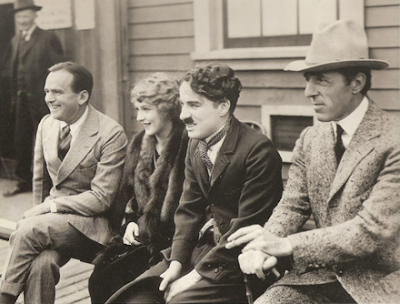stating that the sets and scene artwork of Expressionist films often reveal buildings of sharp angles, great heights, and crowded environments, Strong elements.A number of artists and craftsmen working in the Berlin theater brought the Expressionist visual style to the design of stage sets. This, in turn, had an eventual influence on films dealing with fantasy and horror.
The prime example is Robert Wiene's dream-like film The Cabinet of Dr. Caligari (1920) which is universally recognized as an early classic of Expressionist cinema. Nightmarish sets with twisted structures and landscapes with sharp-pointed forms and oblique, curving lines. Some of these designs were constructions, others were painted directly onto canvases.This film movement paralleled Expressionist painting and theatre in rejecting realism. The creators of the time sought to convey inner, subjective experience through external, objective means.
Their films were characterized by highly stylized sets and acting;they used a new visual style which embodied high contrast and simple editing. The films were shot in studios where they could employ deliberately exaggerated and dramatic lighting and camera angles to emphasize some particular affect - fear, horror, pain. Aspects of Expressionist techniques were later adapted by such directors as Alfred Hitchcock and Orson Welles and were incorporated into many American gangster and horror films.


 Fritz Lang
Fritz LangFritz Lang (December 5, 1890 – August 2, 1976) was a German-Austrian filmmaker, screenwriter, and occasional film producer and actor. One of the best-known émigrés from Germany's school of Expressionism, he was dubbed the "Master of Darkness" by the British Film Institute.
His most famous films include the groundbreaking Metropolis (the world's most expensive film at the time of its release), and M, made before he moved to the United States, which is considered a precursor to the film noir genre.
Metropolis
https://www.youtube.com/watch?v=Q0NzALRJifI
Soviet Montage
Montage Theory, in its rudimentary form, asserts that a series of connected images allows for complex ideas to be extracted from a sequence and, when strung together, constitute the entirety of a film’s ideological and intellectual power. In other words, the editing of shots rather than the content of the shot alone constitutes the force of a film. Many directors still believe that montage is what defines cinema against other specific media.
Sergei Eisenstein
Sergei Mikhailovich Eisenstein ,( 22 January 1898 – 11 February 1948) was a Soviet Russian film director and film theorist , a pioneer in the theory and practice of montage.
Film theorist
Eisenstein was a pioneer in the use of montage , a specific use of film editing .He and his contemporary, Lev Kuleshov , two of the earliest film theorists, argued that montage was the essence of the cinema. His articles and books — particularly Film Form and The Film Sense — explain the significance of montage in detail.
His writings and films have continued to have a major impact on subsequent filmmakers.Eisenstein believed that editing could be used for more than just expounding a scene or moment, through a "linkage" of related images. Eisenstein felt the "collision" of shots could be used to manipulate the emotions of the audience and create film metaphors.
He believed that an idea should be derived from the juxtaposition of two independent shots, bringing an element of collage into film.
He developed what he called "methods of montage":
1.Metric 2.Rhythmic 3.Tonal 4.Overtonal 5.Intellectual
Battleship Potemkin
https://www.youtube.com/watch?v=UNT6xyopdBs
French Impressionism
French impressionist cinema, also referred to as the first avant-garde or narrative avant-garde, is a term applied to a group of French films and filmmakers of the 1920s.
Characteristic
Camerawork
A. Camera distance: close-up (as synecdoche, symbol or subjective image)
B. Camera angle (high or low)
C. Camera movement (independent of subject, for graphic effects, point of view)
Mise-en-scene
A. Lighting (single source, shadows indicating off-screen actions, variety of lighting situations)
B. Décor
C. Arrangement and movement of figures in space
Optical devices
A. As transitions
B. As magical effects
C. As emphasising significant details
D. As pictorial decoration
E. As conveyors of abstract meanings
F. As indications of objectivity (mental images, semi-subjective images, optical subjectivity)
Characteristic editing patterns
A. Temporal relations between shots (Flashback or fantasy)
B. Spatial relation between shots (synthetic, glance/object, crosscutting)
C. Rhythmic relations between shots
Yasujirō Ozu
Yasujirō Ozu ( 12 December 1903 – 12 December 1963) was a Japanese film director and screenwriter .
He began his career during the era of silent films .Ozu made fifty-three films: twenty-six in his first five years as a director, and all but three for the Shochiku studio.Ozu first made a number of short comedies, before turning to more serious themes in the 1930s.
Marriage and family, especially the relationships between the generations, are among the themes in his work.His outstanding works include Late Spring (1949), Early Summer (1951), Tokyo Story (1953), and Floating Weeds (1959).He made great use of ellipsis , where many events are not depicted visually, and he also used a style of cinematography in which the camera rarely moves and is usually positioned below the eye level of the actors.
His reputation has continued to grow since his death, and he is widely regarded as one of the world's most influential directors.
東京物語(1953年)- 小津安二郎 / Tokyo Story - Yasujiro Ozu

























